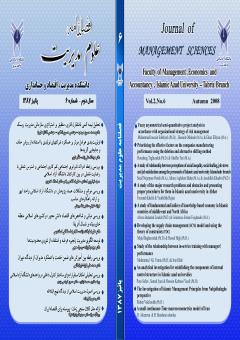بررسی تحلیلی امکان استقرار اجزای ساختار کنترل داخلی در واحدهای دانشگاه آزاد اسلامی
محورهای موضوعی : مدیریت بازرگانیپویا صفاری 1 , صمد ایازی 2 , حسین کرباسی یزدی 3
1 - مربی و عضو هیأت علمی،واحددماوند، دانشگاه آزاد اسلامی، دماوند،ایران
2 - مربی و عضو هیأت علمی،واحد علی آباد کتول، دانشگاه آزاد اسلامی،علی آباد کتول،ایران
3 - استادیار گروه حسابداری، واحد تهران جنوب، دانشگاه آزاد اسلامی،تهران،ایران
کلید واژه: سامانه کنترل داخلی, استقرار, معیارهای استاندارد, اجزای ساختار کنترل داخلی,
چکیده مقاله :
این مقاله به بررسی امکان استقرار اجزای ساختار کنترل داخلی در واحدهای دانشگاه آزاد اسلامی می پردازد. در این راستا پنج فرضیه اصلی و چهار فرضیه فرعی مطرح و مورد پژوهش واقع شده است. جامعه آماری این پژوهش را مدیران مالی و روسای حسابداری و کارشناسان شاغل در واحدهای دانشگاهی سراسر کشور (174واحد) و همچنین حسابرسان و سرپرستان دفتر حسابرسی دانشگاه (50 نفر) تشکیل می دهند. اطلاعات بنیادین این پژوهش به وسیله پرسشنامه استاندارد با طیف پنج گزینه ای لیکرت در چارچوب کیفی جمع آوری شده است که با استفاده از استنباط های آماری و آزمون t مورد تجزیه و تحلیل قرار گرفته است. پس از بررسی نتایج، مشخص شد که محیط کنترلی، فعالیت های کنترلی، نظارت ، درستکاری و ارزش های اخلاقی، صلاحیت کارکنان و نقش هیات امنا در واحدهای دانشگاه آزاد اسلامی مطابق با معیارهای استاندارد می باشد. همچنین نتایج نشان می دهد که ارزیابی ریسک، اطلاعات و ارتباطات، واگذاری اختیار و تعیین مسئولیت در واحدهای دانشگاه آزاد اسلامی مطابق با معیارهای استاندارد نمی باشند.
The study deals with the investigation for establishing the components of internal control structure in Islamic azad universities.In this regard five main hypotheses and four minor ones were studied.The statistical population included financial managers, chief accountants, specialists, auditors,and auditory personnels,in 174 islamic azad universities throughout the country.A standard questionnaire on likert scale with five alternatives were used.In order to test the hypotheses T test was used. The results showed that the controlled environment and activities, supervision, ethical values and honesty, personnels, competence and the role of board of education indices in Islamic azad universities were in accordance with the standard measures, but risk assessment, information and communication, delegation of authority and assigning responsibility indices were not in accordance with the standard measures.
References
Basle Committee on Banking Supervision. (1998). Framework for Internal Control Systems in Banking Organizations. European Financial Management, 15(4), 221-248.
Beiner, S. (2006). An Integrated Framework of Corporate Governance and Firm Valuation. European Financial Management, 12(2), 249-283.
Biswanger, H. (1981). Attitudes toward risk: theoretical implications of an experiment in rural India. Economic Journal. 867-890.
Brewer, D. (2002). Measuring the effectiveness of an internal system control" European Financial Management, 14(4), 633-662.
Burgstahler, D., & Dichev, I. (1997). Earnings management to avoid earnings decreases and losses. Journal of Accounting and Economics, 99-126.
Degeorge, F., Patel, J., & Zeckhauser, R. J. (1997). Earnings management to exceed thresholds. Journal of Business, 407-442.
Duncan, J. (1999). Internal control systems in US churches: An examination of the effects of church size and denomination on systems of internal control. Accounting, Auditing & Accountability Journal, 21(2) , 142-164.
Gemmill, G. (2004). The Impact of Corporate Governance on Closed-End Funds. European Financial Management.
12(5), 725-746
Gneezy, U., & Potters, J. (1997). An experiment on risk taking and evaluating periods. Quarterly Journal of Economics, 631-646.
Jandik, T. (2003). The Evolution of Corporate Governance and Firm Performance in Transition Economies. "18(4), 747-791.
Keasey, K. (2006) Corporate Governance and Information Efficiency in Security Markets. European Financial Management, 12(5), 763-787.
_||_References
Basle Committee on Banking Supervision. (1998). Framework for Internal Control Systems in Banking Organizations. European Financial Management, 15(4), 221-248.
Beiner, S. (2006). An Integrated Framework of Corporate Governance and Firm Valuation. European Financial Management, 12(2), 249-283.
Biswanger, H. (1981). Attitudes toward risk: theoretical implications of an experiment in rural India. Economic Journal. 867-890.
Brewer, D. (2002). Measuring the effectiveness of an internal system control" European Financial Management, 14(4), 633-662.
Burgstahler, D., & Dichev, I. (1997). Earnings management to avoid earnings decreases and losses. Journal of Accounting and Economics, 99-126.
Degeorge, F., Patel, J., & Zeckhauser, R. J. (1997). Earnings management to exceed thresholds. Journal of Business, 407-442.
Duncan, J. (1999). Internal control systems in US churches: An examination of the effects of church size and denomination on systems of internal control. Accounting, Auditing & Accountability Journal, 21(2) , 142-164.
Gemmill, G. (2004). The Impact of Corporate Governance on Closed-End Funds. European Financial Management.
12(5), 725-746
Gneezy, U., & Potters, J. (1997). An experiment on risk taking and evaluating periods. Quarterly Journal of Economics, 631-646.
Jandik, T. (2003). The Evolution of Corporate Governance and Firm Performance in Transition Economies. "18(4), 747-791.
Keasey, K. (2006) Corporate Governance and Information Efficiency in Security Markets. European Financial Management, 12(5), 763-787.


